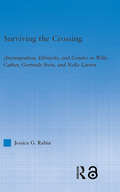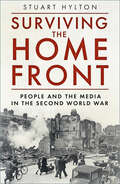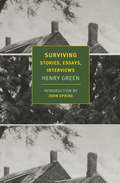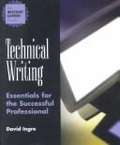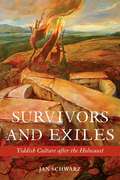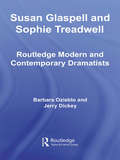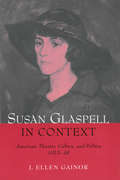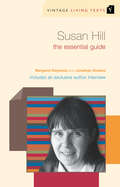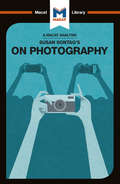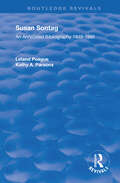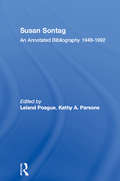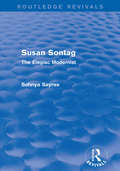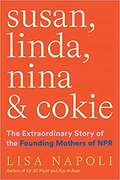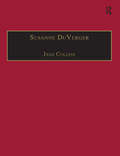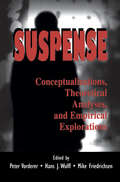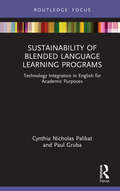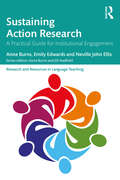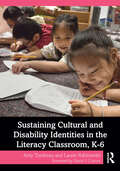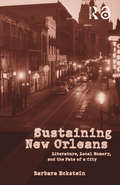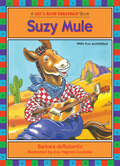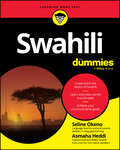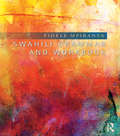- Table View
- List View
Surviving in My World: Growing Up Dalit in Bengal
by Sekhar Bandyopadhyay Manohar Mouli Biswas Angana Dutta Jaideep SarangiIT GIVES US great pleasure to present the English translation of Manohar Mouli Biswas's Bengali autobiography Amar Bhubane Ami Benche Thaki (2013). The book consists of the autobiography and a detailed interview of the author; the latter attempts to bridge the gap between Biswas's days of struggle as a dalit child labourer, as narrated in the autobiography, and his later (so far unrecorded) life as an accomplished dalit literary activist, as one of the leading members of the Bangla Dalit Sahitya Sanstha. His auto¬biography surprises us by its inherent truth and beauty.
Surviving the Crossing: (Im)migration, Ethnicity, and Gender in Willa Cather, Gertrude Stein, and Nella Larsen (Literary Criticism and Cultural Theory)
by Jessica RabinBy examining the fiction of three women modernists--Willa Cather, Gertrude Stein, and Nella Larsen--this book complicates binary paradigms of national, gender, and ethnic identities in the interwar period. In place of essentializing categories of identity, Jessica Rabin explores the liberating and dislocating ramifications of using multiple subject positions as a means of representing identity. While these three authors have been studied in non-intersecting categories (pioneer literature, high modernism, and the Harlem Renaissance, respectively), Jessica Rabin traces their similarities, showing how the dispersal of fixed identities are facilitated by the language of fiction.
Surviving the Home Front: The People and the Media in the Second World War
by Stuart HyltonTerrifying raids, thousands of bombs and countless petrified inhabitants of Britain’s busiest cities. These are the prevailing images of the Blitz and the Home Front in the Second World War. However, for the people who experienced it, it was so much more and affected every aspect of their existence.Surviving the Home Front explores through contemporary newspaper reports and advertisements the effect the Blitz had on issues as varied as fashion, food, transport and more. It explores how facets of humanity showed themselves through individual tales of heroism, eccentricity and humour, but above all Stuart Hylton shows how the irrepressible spirit of the British people overcame a period of harsh austerity combined with the fresh terrors that appeared in their skies almost every night.
Surviving: Stories, Essays, Interviews
by Henry GreenA collection of short stories, journalism pieces, and various writings by the esteemed twentieth-century English novelist Henry Green.Surviving presents a miscellany of Henry Green&’s writing, and is as reflective of his extraordinary and unclassifiable genius for the word as any of his great novels from Living to Loving to Nothing. Readers will find remarkable stories from the 1920s and 1930s; Green&’s telling of his time in the London Fire Brigade during the Blitz; a short, unpublished play, Journey out of Spain; journalism; and the hilarious interview that Terry Southern conducted for The Paris Review. Edited by the novelist Matthew Yorke, Green&’s grandson, Surviving also includes a memoir by Green&’s son, Sebastian Yorke, that is a brilliant portrait of this maverick master.
Survivor's Guide to Technical Writing
by David IngreThis book presents the essentials of communication based on a unique and dynamic model that integrates context, message, audience, purpose, and product (CMAPP).
Survivors and Exiles: Yiddish Culture after the Holocaust
by Jan SchwarzAfter the Holocaust's near complete destruction of European Yiddish cultural centers, the Yiddish language was largely viewed as a remnant of the past, tragically eradicated in its prime. In Survivors and Exiles: Yiddish Culture after the Holocaust, Jan Schwarz reveals that, on the contrary, Yiddish culture in the two and a half decades after the Holocaust was in dynamic flux. Yiddish writers and cultural organizations maintained a staggering level of activity in fostering publications and performances, collecting archival and historical materials, and launching young literary talents. Schwarz traces the transition from the Old World to the New through the works of seven major Yiddish writers--including well-known figures (Isaac Bashevis Singer, Avrom Sutzkever, Yankev Glatshteyn, and Chaim Grade) and some who are less well known (Leib Rochman, Aaron Zeitlin, and Chava Rosenfarb). The first section, Ground Zero, presents writings forged by the crucible of ghettos and concentration camps in Vilna, Lodz, and Minsk-Mazowiecki. Subsequent sections, Transnational Ashkenaz and Yiddish Letters in New York, examine Yiddish culture behind the Iron Curtain, in Israel and the Americas. Two appendixes list Yiddish publications in the book series Dos poylishe yidntum (published in Buenos Aires, 1946-66) and offer transliterations of Yiddish quotes. Survivors and Exiles charts a transnational post-Holocaust network in which the conflicting trends of fragmentation and globalization provided a context for Yiddish literature and artworks of great originality. Schwarz includes a wealth of examples and illustrations from the works under discussion, as well as photographs of creators, making this volume not only a critical commentary on Yiddish culture but also an anthology of sorts. Readers interested in Yiddish studies, Holocaust studies, and modern Jewish studies will find Survivors and Exiles a compelling contribution to these fields.
Susan Glaspell and Sophie Treadwell (Routledge Modern and Contemporary Dramatists)
by Barbara Ozieblo Jerry DickeySusan Glaspell and Sophie Treadwell presents critical introductions to two of the most significant American dramatists of the early twentieth century. Glaspell and Treadwell led American Theatre from outdated melodrama to the experimentation of great European playwrights like Ibsen, Strindberg and Shaw. This is the first book to deal with Glaspell and Treadwell’s plays from a theatrical, rather than literary, perspective, and presents a comprehensive overview of their work from lesser known plays to seminal productions of Trifles and Machinal. Although each woman pursued her own themes, subjects and manner of stage production, this shared volume underscores the theatrical and cultural conditions influencing female playwrights in modern America.
Susan Glaspell in Context
by J. Ellen GainorSusan Glaspell in Context not only discusses the dramatic work of this key American author -- perhaps best known for her short story "A Jury of Her Peers" and its dramatic counterpart,Trifles-- but also places it within the theatrical, cultural, political, social, historical, and biographical climates in which Glaspell's dramas were created: the worlds of Greenwich Village and Provincetown bohemia, of the American frontier, and of American modernism. J. Ellen Gainor is Professor of Theatre, Women's Studies, and American Studies, Cornell University. Her other books include Performing America: Cultural Nationalism in American Theater (co-edited with Jeffrey D. Mason) from the University of Michigan Press.
Susan Hill: The Essential Guide (Vintage Living Texts #13)
by Margaret Reynolds Jonathan NoakesThe Woman in Black, Strange Meeting, I'm the King of the Castle, A Little Bit of Singing and DancingIn Vintage Living Texts, teachers and students will find the essential guide to the works of Susan Hill. Vintage Living Texts is unique in that it offers an in-depth interview with Susan Hill, relating specifically to the texts under discussion. This guide deals with Hill's themes, genre and narrative technique, and a close reading of the texts will provide a rich source of ideas for intelligent and inventive ways of approaching the novels. Also included in this guide are detailed reading plans for all three novels, questions for essays and discussion, contextual material, suggested texts for complementary and comparative reading, extracts from reviews, a critical overview, a biography, bibliography and a glossary of literary terms.
Susan Sontag's On Photography (The Macat Library)
by Nico EpsteinSusan Sontag’s 1997 text, On Photography, brought photographic theory into the university classroom with its staunch defence of the medium as art and inspired a new wave of Marxist Criticism in the field. Sontag explains the way in which we are addicted to images and depend on them for knowledge of our surroundings and the problems and challenges this causes. Already an established academic figure, Sontag brought Walter Benjamin’s theories in into the academic mainstream. The book retains its relevance in the everyday world because of the applicability of its ideas to the world of digital photography.
Susan Sontag: An Annotated Bibliography 1948-1992 (Modern Critics And Critical Studies)
by LELAND POAGUE; KATHY A. PARSONSSusan Sontag: An Annotated Bibliography catalogues the works of one of America's most prolific and important 20th century authors. Known for her philosophical writings on American culture, topics left untouched by Sontag's writings are few and far between. This volume is an exhaustive collection that includes her novels, essays, reviews, films and interviews. Each entry is accompanied by an annotated bibliography.
Susan Sontag: An Annotated Bibliography 1948-1992 (Modern Critics and Critical Studies)
by Leland Poague Kathy A. ParsonsSusan Sontag: An Annotated Bibliographycatalogues the works of one of America's most prolific and important 20th century authors. Known for her philosophical writings on American culture, topics left untouched by Sontag's writings are few and far between. This volume is an exhaustive collection that includes her novels, essays, reviews, films and interviews. Each entry is accompanied by an annotated bibliography.
Susan Sontag: The Elegiac Modernist (Routledge Revivals)
by Sohnya SayresFirst published in 1990, this is the first book-length study of Susan Sontag: essayist and analyst of culture, author of ‘Notes on Camp’ and Illness as Metaphor, novelist, reviewer, and filmmaker. It was modernism, and the excitement it created in her, that "rescued" Sontag from childhood in Southern California and sent her abroad in the 1950s. Sohnya Sayres looks into the foundations and directions of Sontag’s imposing work and in doing so discovers a unity of design and subject that Sontag has only recently acknowledged to have been an ambition all along. Sayres’s Sontag is the "elegiac modernist", committed to a modernism whose high noon has long since passed. And yet Sayres finds in Sontag’s lifelong indebtedness to modernism’s aesthetic an inherent conservatism. While guiding us through the work of a brilliant critic, Sayres questions whether Sontag is not herself caught in the paradoxes of the modernism she herself so much admires. A comprehensive analysis of the work of a remarkable intellectual, this title will be of value to any student of American modernism and literary life.
Susan, Linda, Nina, And Cokie: The Extraordinary Story Of The Founding Mothers Of NPR
by Lisa NapoliIn the years after the Civil Rights Act of 1964, women in the workplace still found themselves relegated to secretarial positions or locked out of jobs entirely. This was especially true in the news business, a backwater of male chauvinism where a woman might be lucky to get a foothold on the “women’s pages.” But when a pioneering nonprofit called National Public Radio came along in the 1970s, and the door to serious journalism opened a crack, four remarkable women came along and blew it off the hinges. Susan, Linda, Nina, and Cokie is journalist Lisa Napoli’s captivating account of these four women, their deep and enduring friendships, and the trail they blazed to becoming icons. They had radically different stories. Cokie Roberts was born into a political dynasty, roamed the halls of Congress as a child, and felt a tug toward public service. Susan Stamberg, who had lived in India with her husband who worked for the State Department, was the first woman to anchor a nightly news program and pressed for accommodations to balance work and home life. Linda Wertheimer, the daughter of shopkeepers in New Mexico, fought her way to a scholarship and a spot on-air. And Nina Totenberg, the network's legal affairs correspondent, invented a new way to cover the Supreme Court. Based on extensive interviews and calling on the author’s deep connections in news and public radio, Susan, Linda, Nina, and Cokie will be as beguiling and sharp as its formidable subjects.
Susanne DuVerger: Printed Writings 1500–1640: Series 1, Part One, Volume 5 (The Early Modern Englishwoman: A Facsimile Library of Essential Works & Printed Writings, 1500-1640: Series I, Part One)
by Jane CollinsThe one work traditionally attributed to Susan DuVerger is her Admirable Events (1639) - a translation of a collection of novellas by Jean Pierre Camus, a French Catholic Bishop - which she dedicated to Queen Henrietta Maria. There is some evidence however to suggest that she was the author of several other works. What little is known of her is based on her literary production - various factors suggest that she was an English Catholic who spent time in exile in France during the Civil War.
Suspense: Conceptualizations, Theoretical Analyses, and Empirical Explorations (Routledge Communication Series)
by Mike Friedrichsen Peter Vorderer Hans J. WulffThis volume begins with the general assumption that suspense is a major criterion for both an audience's selection and evaluation of entertaining media offerings. This assumption is supported not only by the popularity of suspenseful narratives, but also by the reasons users give for their actual choice of media contents. Despite this, there is no satisfying theory to describe and explain what suspense actually is, how exactly it is caused by films or books, and what kind of effect it has on audiences. This book's main objective is to provide that theory by bringing together scholars from different disciplines who are working on the issue. The editors' goal is to reflect the "state of the art" as much as it is to highlight and encourage further developments in this area. There are two ways of approaching the problem of describing and explaining suspense: an analysis of suspenseful texts or the reception process. Researchers who follow the more text-oriented approach identify the uncertainty of the narrative outcome, the threat or danger for the protagonist, the play with time delay, or other factors as important and necessary for the production of suspense. The more reception-oriented scholar focuses on the cognitive activities of audiences, readers' expectations, the curiosity of onlookers, their emotions, and their relationships with the protagonists. A correspondence between the two seems to be quite difficult, though necessary to determine. Both perspectives are important in order to describe and explain suspense. Thus, the editors utilize the thesis that suspense is an activity of the audience (reader, onlooker, etc.) that is related to specific features and characteristics of the text (books, films, etc.). Their question is: What kind of relation? The answer comes from finding out how, why, and which elements of the text cause effects that are experienced as suspense. Scholars from semiotics, literary criticism, cultural studies, and film theory assess the problem from a text-oriented point of view, dealing primarily with the how and which. Other scholars present the psychological perspective by focusing on the cognitive and emotional processes that underlie viewers' experience of suspense; that is, the reception theory tries to answer the question of why suspenseful texts may be experienced as they are.
Sustainability in the Chemical Industry
by Eric JohnsonIt's the new rock and roll. It's the new black. Sustainability is trendy, and not just among hipsters and pop stars. The uncool chemical sector helped pioneer it, and today, companies inside and outside the sector have embraced it. But what have they embraced? Surely not the Brundtland definition of meeting "the needs of the present without compromising the ability of future generations to meet their own needs." Sustainability describes a change in the chemical industry's approach to the external world: to regulators, to greens, to neighbors, to investors and to the general public. Displacing the adversarialism of the 1970s-80s, sustainability is a new approach to social/political conflict, and an attempt to rebuild the industry's long-suffering public image. In practice, it consists of: A 'stakeholder' approach to communications and external relations A rebranding of regulatory compliance and risk management, with the emphasis on their benefits to stakeholders Recognition (and even celebration) of the opportunities, not just the costs, of environmental and social protection The core of this book is a survey of the world's 29 largest chemical companies: how they put sustainability into action (six of the 29 do not), and the six 'sustainability brands' they have created. It begins with a history of stakeholders conflict, before looking at various definitions of sustainability - by academics, by the public and by investors. After the survey and analysis, the book covers sustainability and 'greenwash' plus the ROI of sustainability, and it gives five recommendations.
Sustainability of Blended Language Learning Programs: Technology Integration in English for Academic Purposes (Routledge Focus on Applied Linguistics)
by Paul Gruba Cynthia Nicholas PalikatThis book focuses on the investigation of the sustainability of technology integration in the context of language programs and is based around an 18-month longitudinal study of a blended EAP (English for Academic Purposes) language program situated within a university pathways course. The integration of technology into language teaching and learning in academic English programs often demands substantial investment in professional development, curriculum change, and technological resources. Given the intense effort required, sustainability of such efforts has gained importance, focus, and urgency. Situated in the context of English for Academic Purposes (EAP) programs, this book frames, and investigates, the sustainability of technology integration through a series of case studies of specific technologies: tablet devices, a Learning Management System, and an interactive presentation app. The authors explore sustainable integration of technology; the use of argument-based approaches as a basis for research design; and participant ethnography as a form of data collection. The book concludes by looking at the implications of the research and proposes that change management concepts be applied to better introduce, implement, and most importantly, sustain change involving educational technology integration. The content will be of interest to scholars in TESOL and applied linguistics as well as professional language educators who will benefit from insights into sustaining technology integration in their programs.
Sustaining Action Research: A Practical Guide for Institutional Engagement (Research and Resources in Language Teaching)
by Anne Burns Emily Edwards Neville John EllisThis book is a practical guide for English language teachers and teacher educators seeking to carry out and promote teacher action research within their institutional context. Based on contemporary theory and a reflexive and social approach to teacher professional development and learning, it offers readers structured methodologies and concepts, wide-ranging hands-on activity sets, and focused suggestions for appropriate and sustainable ways to implement action research across an institution. Experts Anne Burns, Emily Edwards and Neville John Ellis close the book by presenting ideas for conducting teacher research through reflective practice, exploratory practice and action research.
Sustaining Cultural and Disability Identities in the Literacy Classroom, K-6
by Amy Tondreau Laurie RabinowitzIdeal for literacy methods and elementary instruction courses, this book brings together three strands of educational practice—Culturally Sustaining Pedagogy (CSP), Disability Sustaining Pedagogy (DSP), and balanced literacy—to present a cohesive, comprehensive framework for literacy instruction that meets the needs of all learners. Situating balanced literacy instruction within the current debate on how to best teach elementary school literacy, this book prepares pre-service and in-service teachers to work with racially, ethnically, and linguistically diverse students of all abilities and disabilities and addresses effective curriculum design, lesson planning, and assessment. Chapters offer real-world classroom examples and lesson plans, charts, and discussion guides for CSP/DSP-infused instruction for each component of a balanced literacy instructional block.
Sustaining New Orleans: Literature, Local Memory, and the Fate of a City
by Barbara EcksteinFirst published in 2006. Routledge is an imprint of Taylor & Francis, an informa company.
Sutpen's Design: Interpreting Faulkner's Absalom, Absalom!
by Dirk Kuyk Jr.From the prologue: "This book began in an undergraduate class on William Faulkner's Absalom, Absalom! Because the students kept referring to "Sutpen's design" without pausing to define it, I asked, "What, exactly, was Sutpen trying to do?" They gave the answers that I expected. They had, after all, read not only the novel but also some of the criticism; and they had accepted, as I had, the basic account that has been developed since Absalom was published in 1936. When I asked for evidence to back up their answers, the students pointed to passages that every critic would cite. Ordinarily, I would have accepted the citations; this time, to make the students defend their interpretations, I set out to challenge them-and discovered that the passages fail to support the interpretations. When they collapsed, my interpretation also collapsed; it stood on the same ground. So did all the criticism that I had read; it would also fall. Now, after surveying virtually all the criticism of Absalom, I have concluded that the account that forms the basis for that criticism is mistaken. This book argues that the account is flawed in two crucial ways. It misunderstands both what Sutpen is trying to do and how the narration works. As a result of the first misunderstanding the account fails to explain, for example, why Sutpen rejects Bon and what Sutpen hoped for in striving to complete his design. The second misunderstanding has led critics to see Absa lom as a web of hypothetical narratives that cannot be verified. Because the book's characters serve as narrators and are patently unreliable, critics have doubted that a trustworthy narrative can be derived from what we are given. I believe that the book's narrative technique reveals a way to authenticate the narrative. These ideas about Sutpen's design and about the narration lead to a detailed reinterpretation of Absalom."
Suzy Mule: Long Vowel U (Let's Read Together ®)
by Barbara deRubertisLet&’s Read Together books merge rhyme and vowel sounds in delightfully zany stories kids will want to read again and again. Each of the 15 books in this classic series by award-winning author/educator Barbara deRubertis will give your child a jumpstart on reading success."Story lines are silly and inventive, and recall Dr. Seuss&’s Cat in the Hat for the building of rhythm and rhyming words." —School Library JournalSuzy Mule has the flu and is feeling blue. Then she gets a super idea: go south! (This easy-to-read story features the long &“u&” vowel sound.)
Swahili For Dummies
by Seline Okeno Asmaha HeddiLearn the official language of Kenya and Tanzania Swahili For Dummies will teach you the basics of Swahili, so you can start conversing in Africa’s language of commerce. This book introduces you to the foundations of Swahili grammar and enables you to engage in basic conversations. With the simplified Dummies learning process, you’ll quickly get a grasp on the language, without complex terms and confusing explanations. You’ll also move through the book at a comfortable pace, so you’ll be familiar with what you’ve learned before moving on to more complex stuff. Focus on communication and interaction in everyday situations, so you can actually use the language you’re studying—right away. Understand the basics of Swahili Learn everyday words and phrases Gain the confidence to engage in conversations in Swahili Communicate while traveling and talk to Swahili-speaking family members Swahili For Dummies is for readers of all ages who want to learn the basics of Swahili in a no-stress, beginner-friendly way. Swahili teachers will also love sharing this practical approach with their students.
Swahili Grammar and Workbook
by Fidèle MpiranyaSwahili Grammar and Workbook provides a practical and comprehensive companion to Swahili grammar, filling in gaps left by other textbooks. Presenting the essentials of Swahili grammar in a highly accessible fashion, it reduces complex language topics to helpful rules and mnemonic aids, enabling maximum grammar retention and accurate usage. Grammar points are followed by multiple examples and exercises, allowing students to consolidate and practice their learning. No prior knowledge of linguistic terminology is required. Key features include: Twenty five language notes covering key topics such as: personal pronouns; the Swahili noun class system; special class combinations; the imperative, the subjunctive, and the conditional moods; the use of comparatives; the use of monosyllabic verbs; the passive form and various other forms of verb extensions; the relative clause Clear, detailed and jargon-free grammatical explanations supported by an assortment of helpful diagrams, charts and tables and many relevant and up-to-date examples A wide range of communication-oriented exercises to reinforce learning and develop students’ ability to use Swahili actively Audio files to support pronunciation practice, clearly linked to relevant sections of the book and available for free download at http://www.routledge.com/books/details/9781138808263/ Four appendices, Swahili-English and English-Swahili vocabulary lists, a bibliography and an index presented at the back of the book for easy access to information. Written by a highly experienced instructor, Swahili Grammar and Workbook will be an essential resource for all students and teachers of Swahili. It is suitable for use both as a companion reference text in language courses and as a standalone text in independent grammar classes.

